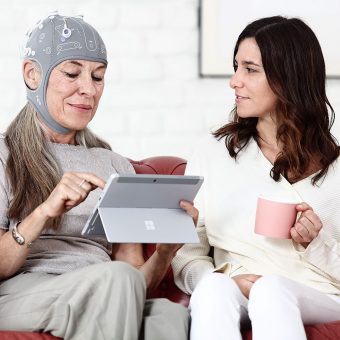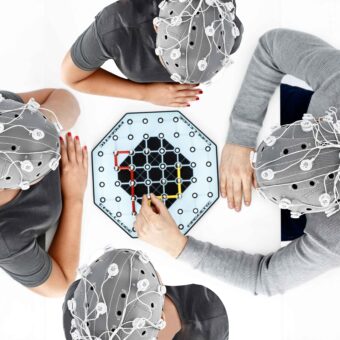I had the opportunity to attend the International Brain-Computer Interface (BCI) Meeting1, which was held at the Asilomar Conference Center in Monterrey CA, from 3rd to 7th June, 2013. This is one of the main conferences in the BCI research field. It is held every second year and attended by many of the BCI pioneers. One of the most interesting and new topics, what we could call the latest trends from my perspective, discussed there was the combined utilization of electrical brain stimulation and Brain-Computer Interfaces.
Improving BCI performance through brain electrical stimulation
I was most interested in this combination because I have worked in the past with both techniques. The main idea of this approach is that electrical brain stimulation2 can be used for making the brain fit for the different BCI modalities3. At the conference most of the presented papers dealt with the combination of transcranial direct current stimulation (tDCS) and motor imagery, one of these BCI modalities. But this could be further improved with other types of transcranial Current Stimulation (tCS) as I envisage later in this post.
Current trend in motor imagery BCI
In motor imagery the controlling subject is told to imagine movements of different parts of her body, e.g. left hand, right hand, tongue, feet. This is demonstrated to activate the motor cortex with different patterns. The motor imagery BCI system is then trained to distinguish one activation from the other. Being known the capability of tDCS to modulate the cortex excitability well known, researchers are trying to use this capability in order to improve the response to the imagined movements. I mean by modulation the fact that you can favor or hinder the excitation of a particular part of your cortex by placing electrodes close to this part and changing the polarity of the stimulating DC current that goes through it. So the background idea is that you can favor the excitability of the area responsible of e.g. the right hand movement in order to make the right hand imagery movement easier to be discriminated by the BCI analysis system.
tDCS priming as inspiration
It is a very interesting idea in my opinion. BCI systems have been developed now for some years but the feasibility of their usage in real-world conditions is challenged by the intrinsic variability of EEG4. So the strategy is to use external brain stimulation as priming of the internal motor cortex activation that is achieved through movement imagery. Such usage of tDCS for priming has already been tested in TMS and tACS therapeutic protocols5, which are based on the application of AC current. I suppose the starting point of the combination BCI-tDCS comes from this usage. In this kind of applications the tDCS is used to prepare a particular area of the cortex for the therapeutical action of the TMS or tACS stimulation.

Looking ahead: further development of the marriage BCI-tCS
Being two of the three main BCI modalities related to oscillatory activation of the cortex, I would say the usage of tACS priming seems more useful to me than this of tDCS. The aforementioned motor imagery and the Steady-State Visual Evoked Potentials (SSVEP) are the two modalities I mean. Both of them are based on modifications of oscillatory activity at the mu-rhythm (roughly 10-25 Hz) and the flickering stimulation frequency (roughly 6-25 Hz), respectively. In tACS an AC current with a particular frequency is applied to the brain. It looks like its main effect is favoring the activation of cortical rhythms at that stimulating frequency (and I say “it looks like” because this has not been fully proven). So for instance Zaehle and colleagues6 have shown that stimulating at the individual alpha rhythm, the amplitude of the alpha peak increases in human subjects.
So the rationale I am following is that if tACS favors the activation of oscillatory rhythms, it would be better suited for the SSVEP and the motor imagery priming. Here experimental researchers should design and check protocols where this combination is achieved. I am not aware of any work in the literature describing such an approach. But some of you might know. Would you be so kind to share?



